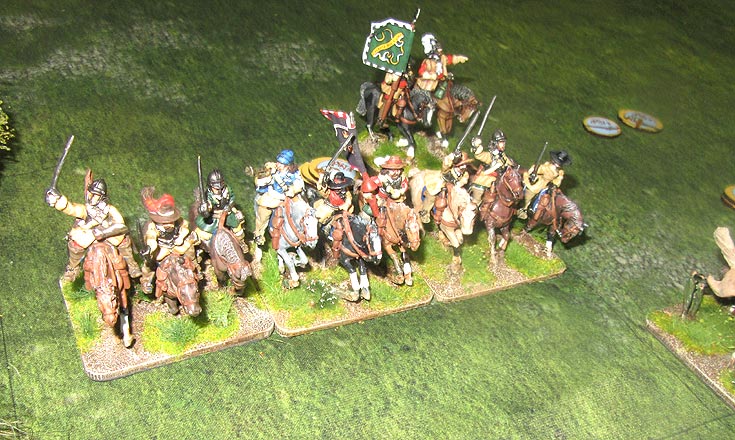
The Battle of Kirby Lane 1643
14th July 2022, 0 Comments
The English Civil War, For King & Parliament, 28mm
Once again there were just two of us gaming this week. So, we opted for a small English Civil War encounter – part of our continued feud between the Royalist Earl of Doncaster (Sean’s alter ego) and my own Parliamentarian one, the Earl of Scunthorpe. In this encounter the two noblemen clashed on a quiet Yorkshire lane between Barnsley and Rotherham. As I didn’t really put much effort into the scenario we each had matching forces – three regiments of foot, and two regiments of horse, trained to fight in the Swedish style. All troops were rated as “seasoned”. As for Swedish style cavalry, the Parliamentarian Eastern Association had made the switch from the Dutch style by late 1643, so why not the followers of my fictitious Lincolnshire earl, eh?
As I didn’t really put much effort into the scenario we each had matching forces – three regiments of foot, and two regiments of horse, trained to fight in the Swedish style. All troops were rated as “seasoned”. As for Swedish style cavalry, the Parliamentarian Eastern Association had made the switch from the Dutch style by late 1643, so why not the followers of my fictitious Lincolnshire earl, eh?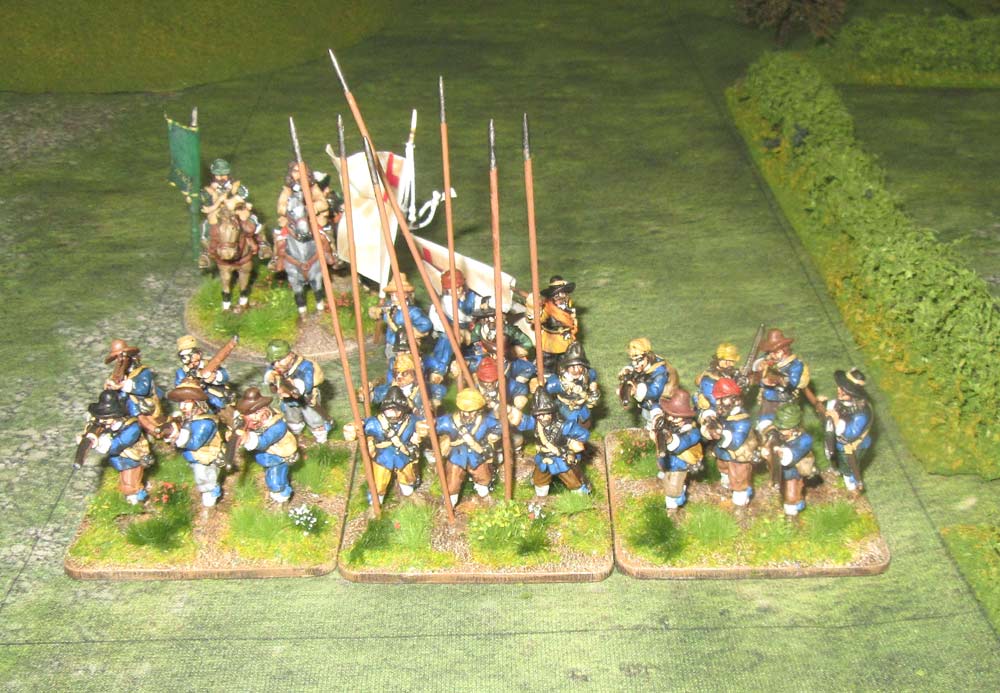 The game was fought out on a 6×4 foot table, with just a few hedges to spoil the view. both entered from opposite long edges, and our deployments pretty much matched each other, with the foot on the right and the horse on the left. Oh, as somebody asked me, my foot are based on 60x60mm bases, in blocks of pikes or muskets. Each regiment also has a 60x40mm command base with four figures on it – two ensigns, an officer and a drummer). That works out at about 22-24 figures per regiment.
The game was fought out on a 6×4 foot table, with just a few hedges to spoil the view. both entered from opposite long edges, and our deployments pretty much matched each other, with the foot on the right and the horse on the left. Oh, as somebody asked me, my foot are based on 60x60mm bases, in blocks of pikes or muskets. Each regiment also has a 60x40mm command base with four figures on it – two ensigns, an officer and a drummer). That works out at about 22-24 figures per regiment.  Right, we both advanced cautiously – especially the rival cavalry, who were waiting for the infantry clash to begin. Boothroyd’s and Fairfax’s foot managed to form up inside a hedge enclosure, which gave them some cover, while Rotherham’s foot on their left blocked the lane. In Sean’s Royalist force, Barraclough’s yellowcoats and Doncaster’s foot stayed on the east side of the lane, while Arkwright’s foot formed up in the lane, ready to force their way through Rotherham’s Parliamentarian bluecoats.
Right, we both advanced cautiously – especially the rival cavalry, who were waiting for the infantry clash to begin. Boothroyd’s and Fairfax’s foot managed to form up inside a hedge enclosure, which gave them some cover, while Rotherham’s foot on their left blocked the lane. In Sean’s Royalist force, Barraclough’s yellowcoats and Doncaster’s foot stayed on the east side of the lane, while Arkwright’s foot formed up in the lane, ready to force their way through Rotherham’s Parliamentarian bluecoats. The battle started with a musketry exchange between Rotherham’s foot and Barraclough’s firing over the hedge lining the eastern side of the lane. This wasn’t very effective, but at least the yellowcoats suffered a disordering “hit”. Further to the east, the two cavalry lines edged towards each other, until I weakened and launched a charge. After all, adopting the Swedish style meant charging, right?
The battle started with a musketry exchange between Rotherham’s foot and Barraclough’s firing over the hedge lining the eastern side of the lane. This wasn’t very effective, but at least the yellowcoats suffered a disordering “hit”. Further to the east, the two cavalry lines edged towards each other, until I weakened and launched a charge. After all, adopting the Swedish style meant charging, right? On the Parliamentarian side, Thackrey’s horse were on the left and Harrison’s on the right. In the melee between Harrison’s and Longfellow’s, the Royalists managed to score a hits, disordering their opponents. As this was simultaneous I got to turn my cards though, and inflicted a matching hit on Greenwood’s horse. In the other melee between Thackrey’s and the Royalist Greenwood’s regiment of horse, it didn’t go so well, and I suffered two hits, which meant Thackrey’s horsemen fled the field.
On the Parliamentarian side, Thackrey’s horse were on the left and Harrison’s on the right. In the melee between Harrison’s and Longfellow’s, the Royalists managed to score a hits, disordering their opponents. As this was simultaneous I got to turn my cards though, and inflicted a matching hit on Greenwood’s horse. In the other melee between Thackrey’s and the Royalist Greenwood’s regiment of horse, it didn’t go so well, and I suffered two hits, which meant Thackrey’s horsemen fled the field.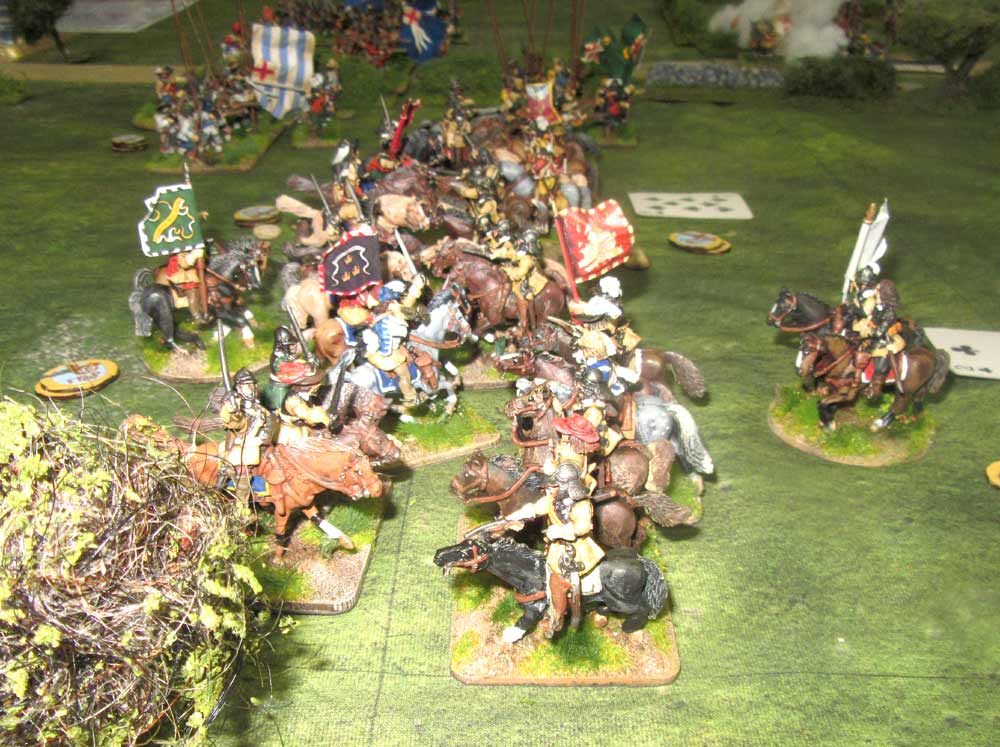 What was even worse, the Parliamentarian cavalry leader Colonel Tobias Arkwright was cut down, leaving my horse completely leaderless. the only silver lining was that the Royalist victors then “pursued” off the northern table edge. it would take time for their leader Sir Edward Greenwood to rein them in and return them to the fray. Meanwhile I managed to score another hit on Longfellow’s horse, and they also routed off the table.
What was even worse, the Parliamentarian cavalry leader Colonel Tobias Arkwright was cut down, leaving my horse completely leaderless. the only silver lining was that the Royalist victors then “pursued” off the northern table edge. it would take time for their leader Sir Edward Greenwood to rein them in and return them to the fray. Meanwhile I managed to score another hit on Longfellow’s horse, and they also routed off the table.  My satisfaction was brief though, as they had to advance into the ground vacated by the Royalist cavalry. So, Doncaster’s foot simply turned to face the cavalry, and delivered a volley on their flank which utterly broke the last of my horse. Now though, with all the cavalry gone save Greenwood’s horse which was impetuously galloping north towards Barnsley, this was now a purely infantry fight.
My satisfaction was brief though, as they had to advance into the ground vacated by the Royalist cavalry. So, Doncaster’s foot simply turned to face the cavalry, and delivered a volley on their flank which utterly broke the last of my horse. Now though, with all the cavalry gone save Greenwood’s horse which was impetuously galloping north towards Barnsley, this was now a purely infantry fight. 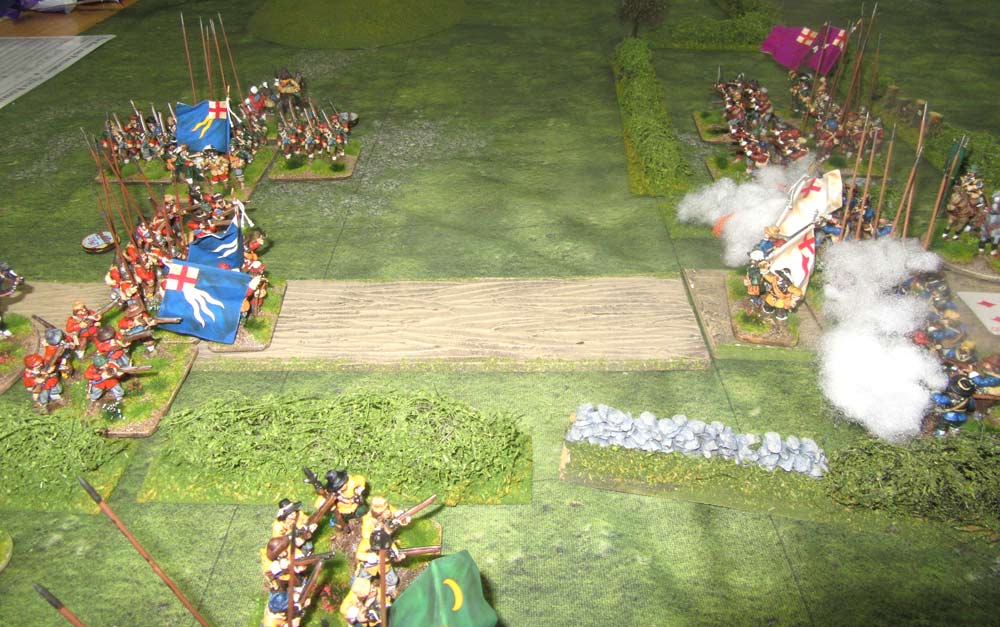 As Sean’s foot didn’t seem to want to advance, I advanced out of my enclosure and encircled Arkwright’s redcoats. Soon they were being shot at from three sides, although the Royalist yellowcoats still kept firing into my bluecoats, trying to distract them. In the end though, Arkwrights’ foot suffered their third hit, and they routed. This then, is where the fight started to get pretty silly.
As Sean’s foot didn’t seem to want to advance, I advanced out of my enclosure and encircled Arkwright’s redcoats. Soon they were being shot at from three sides, although the Royalist yellowcoats still kept firing into my bluecoats, trying to distract them. In the end though, Arkwrights’ foot suffered their third hit, and they routed. This then, is where the fight started to get pretty silly. 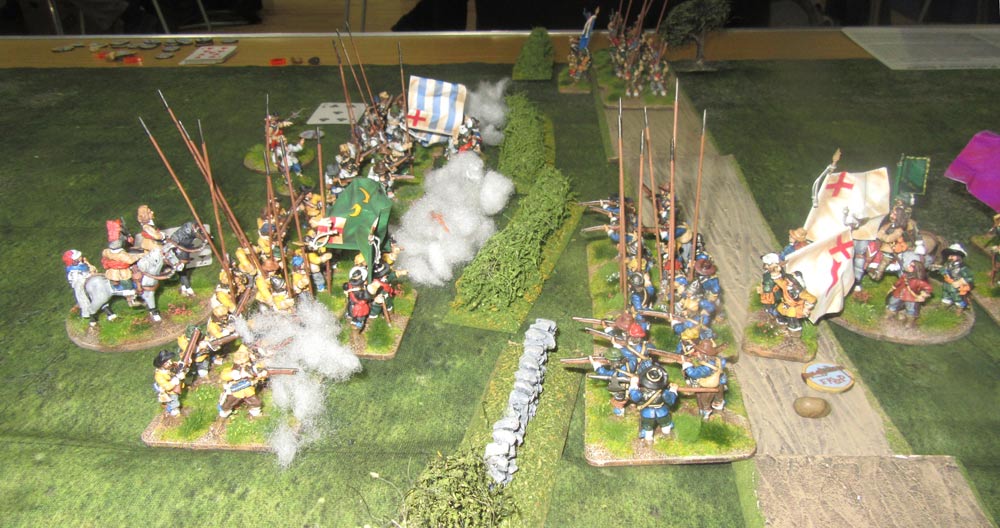 Picture it. We were now arrayed up and down Kirby lane, with two Royalist foot regiments on one side of the hedge, and three Parliamentarian ones on the other side. Soon everyone was disordered, making it harder to hit the enemy, you need a 9-10 rather than the usual 8-10, and the hedge made it easier for any hits to be saved. We were also virtually out of ammunition. After a few turns of this it was clear that nobody was going to achieve very much that day! So, I pulled Scunthorpe’s bluecoats back to rally, and Sean did the same with Barraclough’s yellowcoats, followed by the rest of his line. At that poiint we decided to call the game a draw, despite the return of Greenwood’s cavalry. So, the rival Earls duly led their troops back to Barnsley and Rotherham, to try their luck another day.
Picture it. We were now arrayed up and down Kirby lane, with two Royalist foot regiments on one side of the hedge, and three Parliamentarian ones on the other side. Soon everyone was disordered, making it harder to hit the enemy, you need a 9-10 rather than the usual 8-10, and the hedge made it easier for any hits to be saved. We were also virtually out of ammunition. After a few turns of this it was clear that nobody was going to achieve very much that day! So, I pulled Scunthorpe’s bluecoats back to rally, and Sean did the same with Barraclough’s yellowcoats, followed by the rest of his line. At that poiint we decided to call the game a draw, despite the return of Greenwood’s cavalry. So, the rival Earls duly led their troops back to Barnsley and Rotherham, to try their luck another day. 

